10 Most Famous Neoclassical Paintings and Artworks
The Neoclassical era began in the latter part of the 18th century after a focus on Greek and Roman Classical themes became popular with fledgling artists and students.
It was quite common during this fourth dimension for most aspiring artists from Europe to travel to Italy and Hellenic republic in their efforts to study some of the more prominent fine art movements from history that were founded there.
A renewed interest in Classical fine art, history and lifestyle was sparked past the rediscovery of Pompeii and Herculaneum in the middle of the 18th century.
Artists sought to once over again explore the concepts that had been pop in the Classical time period. This new focus on Classical themes involved artists creating works that featured historically accurate depictions of various scenes from history.
In this commodity, nosotros'll take a closer look at some of the more well-known Neoclassical paintings and scultpures and examine the inspiration and history regarding the works and the artists who created them.
Famous Neoclassical Paintings
ane. The Death of Marat – Jacques-Louis David
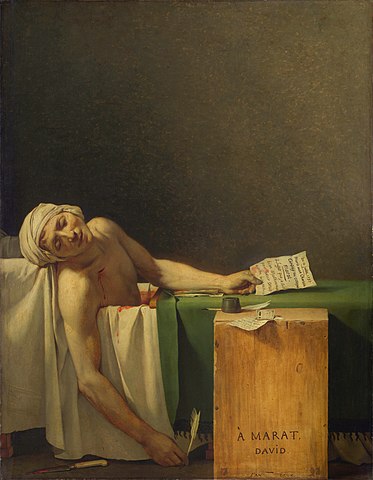
Jean-Paul Marat was i of the virtually famous figures that's credited with leading the French Revolution during the late 1700'southward. He was a journalist who afterwards served equally a politician and his decease marked a turning bespeak in the fight to wrench the country from the hands of wealthy aristocrats.
Marat was stabbed to death by a woman who sympathized with a group that Marat had been responsible for virtually eradicating.
Marat'due south expiry was depicted in a work titled The Death of Marat, which is now considered to be a famous Neoclassical painting.
Jacques-Louis David created the painting in 1793, only months subsequently Marat's assassination every bit an effort to commemorate the political figure's life and efforts to fight for the central crusade that would be the driving force of the encarmine revolution.
David is remembered as one of the about prolific artists from the Neoclassical era and his works oftentimes centered around famous events in history. This painting features a dying Marat lying in a bath with his hand clutching a note. The words on the paper include a bulletin related to his killer, a woman named Charlotte Corday.
two. Psyche Revived past Cupid'southward Kiss – Antonio Canova
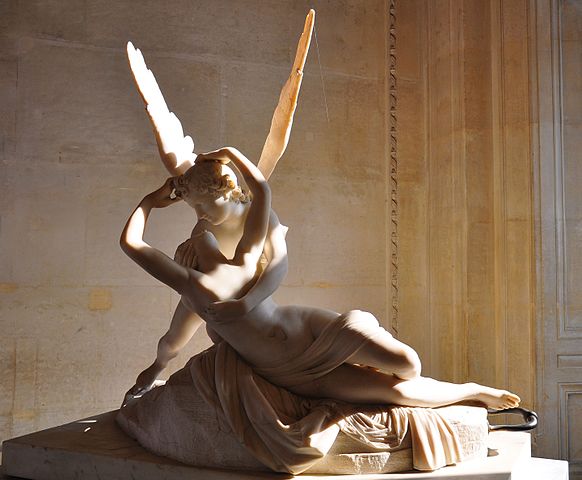
Antonio Canova is one of the most widely-heralded sculptors of the Neoclassical motility. During his career, information technology became popular for art galleries to have nightly displays of sculptures that were illuminated but past torchlight.
Canova was an artist who fully embraced this practise and was said to have put the finishing touches on each of his works late at night by the light of a candle.
One such work that gained a high amount of praise is known as Psyche Revived past Cupid's Buss. This sculpture was finished in 1793, but there were other versions of this same piece of work that were completed later by the artist. The sculpture is a distinct representation of the Classical theme of Romanticism that was so prevalent during this fourth dimension.
Canova sought to create a piece of work that portrayed Cupid, the Roman god of love and desire reviving Psyche with a kiss.
The story of Psyche and Cupid was a well-known love story from Roman mythology and the sculpture depicts a winged Cupid holding the nude figure of Psyche who is seen reaching upward to embrace him.
3. Oath of the Horatii – Jacques-Louis David
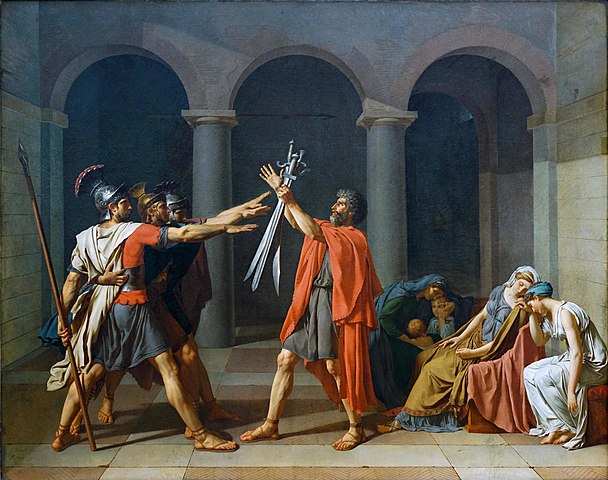
Much of Jacques-Louis David's early on work revolved around the most prominent stories and events from history during the Classical era.
While he was studying at the French Academy in Rome during the early 1780's, he adult a fascination with some of the most famous figures and legends from Roman history. During this time, he created a piece of work that many critics and scholars indicate to as David's most famous painting in 1784.
The piece of work is titled Oath of the Horatii and is known for incorporating many elements from the Neoclassical style that include bold colors and a heavy emphasis on historical accuracy for what was believed to have been the actual story behind the issue.
The painting centers around a legend that dates back to the 7th century B.C. which tells of a dispute between 2 cities.
According to the legend, iii brothers from the Horatii family fought 3 brothers from another family from the rival metropolis. The only surviving Horatii blood brother managed to defeat the three enemies.
This painting depicts the father of the Horatii brothers holding their swords equally the brothers salute him before heading to battle.
4. Death of General Wolfe – Benjamin W
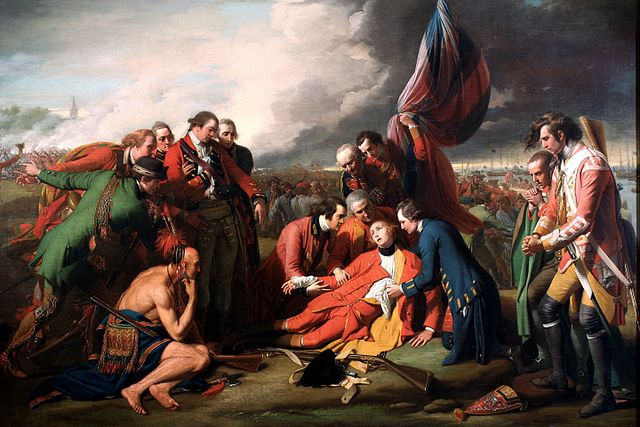
The Seven Years War was a bloody and hard-fought campaign that was fought between the French and the British for dominance of what was then the colonies owned by France.
1 of the almost famous battles from the war is known as the Boxing of Quebec, which took identify in 1759. Despite having only lasted 15 minutes, the Battle of Quebec was intense and resulted in the death of British General James Wolfe.
Artist Benjamin Due west commemorated the battle in a painting titled Death of General Wolfe. This 1770 painting is one of the more than iconic works from the Neoclassical era, but information technology is also i of the few that is historically inaccurate in some of the most of import details of the actual events.
The painting portrays Wolfe dying in the arms of his officers, but in reality, he was killed instantly past a hail of bullets from the French soldiers.
5. Voltaire – Jean-Antoine Houdon
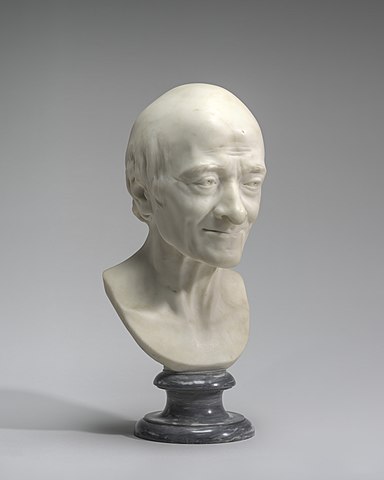
Jean-Antoine Houdon was a widely-celebrated sculptor and painter from the Neoclassical movement. 1 of his most famous sculptures is a bust that depicts the highly-acclaimed author and philosopher, Voltaire.
This simple sculpture depicts the head and face of Voltaire in a manner that was characteristic of Houdon's style.
It shows an aged Voltaire with a somewhat astute expression on his face. Houdon's sculpture of Voltaire displays him in a very detailed manner and the viewer tin conspicuously tell that the figure is that of an old human who has lost his teeth and hair, yet nevertheless maintains a sense of vitality in his eyes and expression.
half dozen. Cornelia, Mother of the Gracchi, Pointing to her Children as Her Treasures – Angelica Kauffman
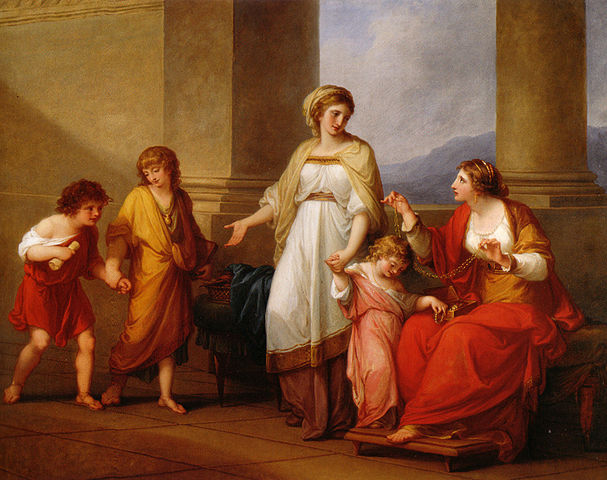
Angelica Kauffman was a Swiss painter during the height of the Neoclassical era. She created a range of artworks depicting figures from the time menses in Republic of austria, where she lived for many years.
I of the artist's nigh famous works that'south too lauded as an iconic Neoclassical painting is one that she painted in 1785.
The work is titled Cornelia, Mother of the Gracchi, Pointing to her Children as Her Treasures. It depicts a woman named Cornelia, who was said to be the mother of esteemed Roman leaders Tiberius and Gaius Gracchus.
According to the legend, a woman met Cornelia and showed her an array of jewels and treasures that she had accumulated, claiming that they were her most prized possessions. When the woman asked to see Cornelia's most prized treasures, she gestured to her children, who would become the hereafter rulers of Rome.
7. Achilles Receiving the Ambassadors of Agamemnon – Jean-Auguste-Dominique Ingres
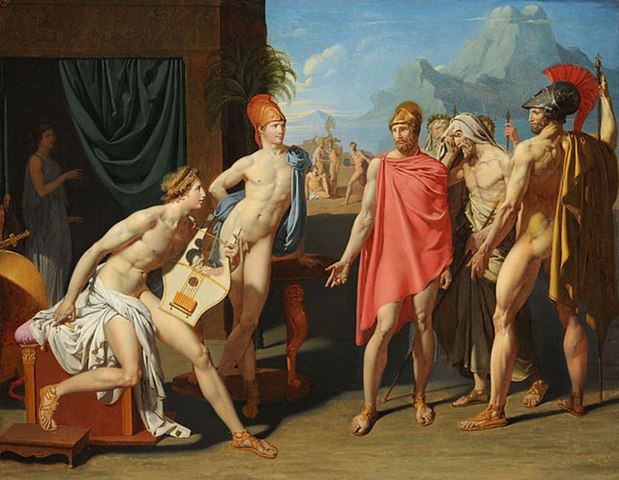
Jean-Auguste-Dominique Ingres was an artist who fully embraced much of the mystique that surrounded the ancient legends told in Roman and Greek manuscripts.
Many of Ingres' paintings depict various scenes from history or Roman mythology, which was quite mutual among some of the more famous Neoclassical artists of the time menstruum.
Ane of his most famous paintings is said to be a work titled Achilles Receiving the Ambassadors of Agamemnon. The painting depicts a moment from the pop story of the Trojan State of war that involved the forces of Greece and Troy.
Ingres' painting depicts Achilles, the legendary hero and god-similar warrior, speaking with ambassadors of the Greek ruler, Agamemnon, who are begging him to render to the war effort.
Ingres created this painting as an entry in a famous contest known equally Prix de Rome, which was substantially a scholarship contest for immature and aspiring artists and sculptors.
viii. The Birth of Venus – William-Adolphe Bouguereau
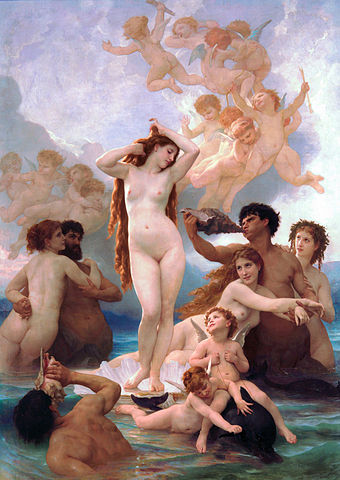
French painter William-Adolphe Bouguereau is regarded as 1 of the most well-known figures from the Neoclassical motility.
Many of his works featured scenes from Roman or Greek mythology, but many of them were done in strikingly realistic detail. Many of these paintings involved nude women, which were somewhat controversial at the fourth dimension.
One of Bouguereau'due south most famous paintings was a work depicting the Roman goddess of love, beauty and desire, Venus, who the Greek mythology legends refer to as Aphrodite.
Likewise Read: Famous Greek Mythology Paintings
In his painting, titled The Birth of Venus, Bouguereau depicts the goddess coming forth out of the sea. She is seen continuing on a conch beat, surrounded past other gods and goddesses from Roman mythology who are all gazing at her with wonder.
Venus is said to have been the prototype of female dazzler and physique and the artist'due south work depicts her as having a almost-perfect figure and long, flowing hair.
9. Parnassus – Anton Raphael Mengs
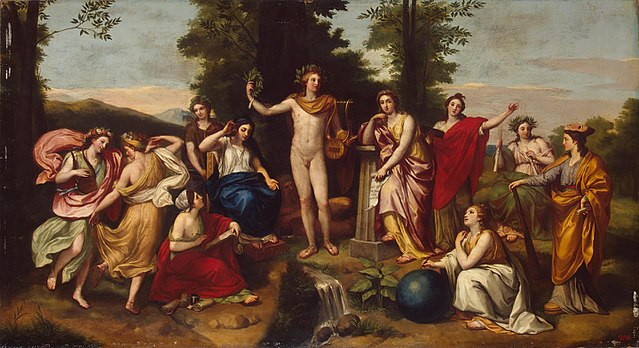
One of the about iconic paintings of the Neoclassical era was done by Anton Raphael Mengs in 1784. Mengs was a prominent German creative person who developed a reputation as an artist during the Rococo menses, but would later be i of the main figures that helped shape the early Neoclassical period.
Meng was deputed to paint a large fresco in one of Rome's most famous structures, the Villa Albani. The work that Meng created would instantly be recognized past art critics and his peers at the time every bit a masterpiece.
The painting is titled Parnassus and depicts a figure known every bit Mnemosyne, who was the female parent of the nine Muses, who were prominent figures from Roman mythology.
The painting was celebrated as a pivotal work that defined the new era of Neoclassical painting and artwork.
10. King Lear Weeping over the Dead Body of Cordelia – James Barry
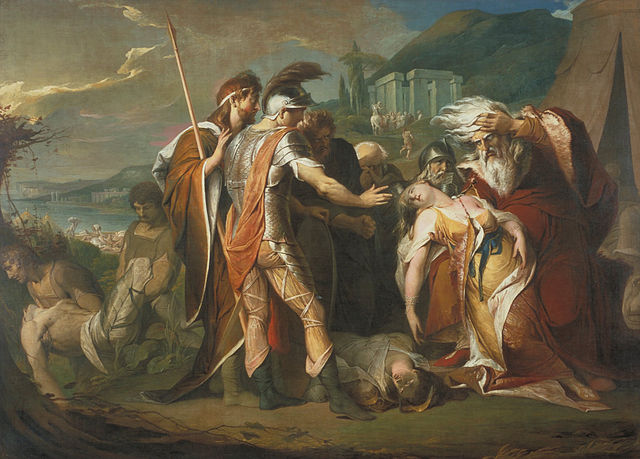
The works of Irish gaelic painter James Barry were not widely recognized until long subsequently his death in 1983. He is known to take been influential in the life of renowned poet, creative person and printmaker William Blake and his paintings hold a peculiar sense of glowing beauty and detail that critics merits is quintessential to the Neoclassical way.
Sadly, he did not enjoy much praise for his works during his lifetime and is said to have died with many of his works existence nevertheless undiscovered by art critics and collectors.
One of Barry's nigh famous paintings is titled Male monarch Lear Weeping over the Dead Body of Cordelia. Information technology was commissioned by Alderman Boydell's as the painting was to be included in his 'Shakespeare Gallery.' The 1788 work appears to be very Classical in nature, but depicts a famous British fable instead of the fourth dimension period'south usual Greek or Roman theme.
Barry portrays a tragic scene from the Shakespearean work in which King Lear is seen belongings his deceased daughter Cordelia. The artist farther added British elements to the piece of work by including the image of Stonehenge in the background.
Source: https://www.artst.org/famous-neoclassical-paintings/
0 Response to "10 Most Famous Neoclassical Paintings and Artworks"
Post a Comment